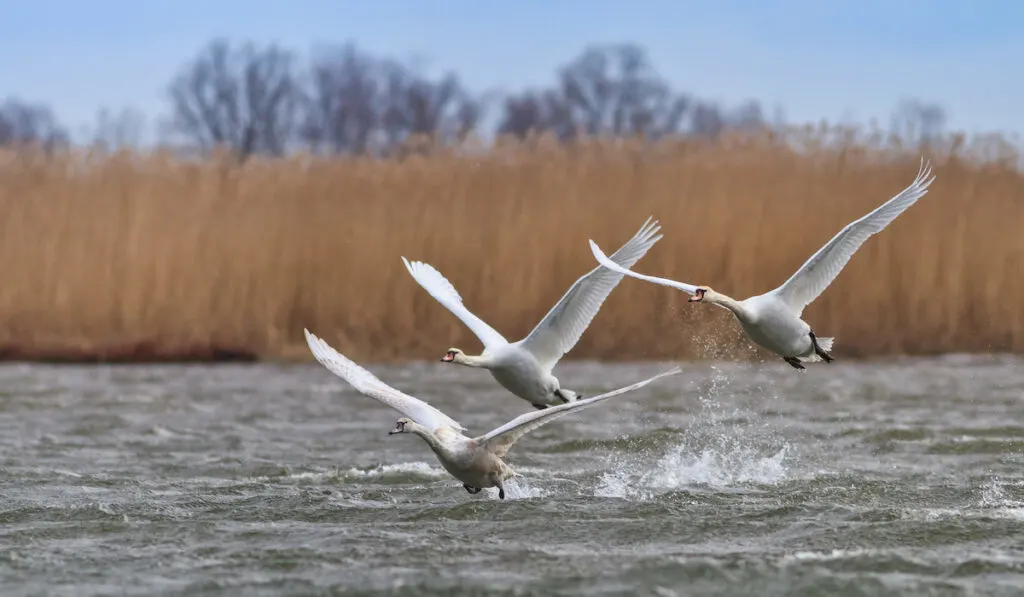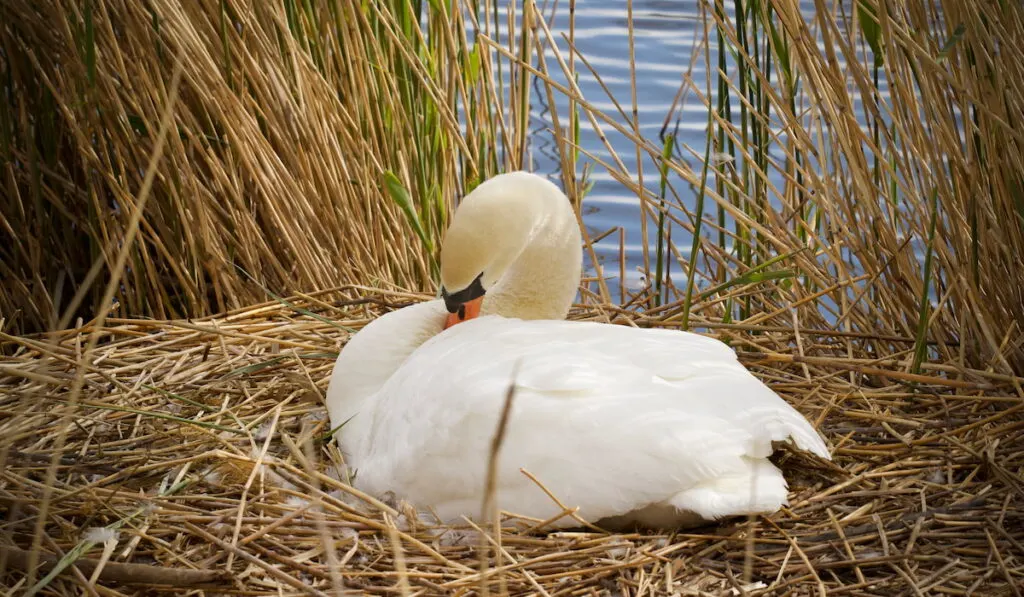Swans are one of the large, audacious, and gorgeous mortals with a long beautiful neck, big body, and majestic wings and feet. You may have seen swans somewhere floating on a stream or water pool and thought, “Do swans fly?”

All species of swan can fly very high and with great speed. Though Swans glide gracefully in the water, they are also capable of moving very fast in the air.
Like other migratory birds that fly to migrate seasonally, Swans also fly higher at great speed to migrate from a cold place to a moderate one. They can fly at speeds of 60 miles per hour or more.
Swans belong to the family of big birds called Anatidae and genus Cygnus. They are close relatives to ducks and geese. Swans love to habitat in green grounds near the slow lakes, rivers, water pools, and streams.
There are many types of swans almost all the swans can fly higher but a few are not capable of flying in the air, such a type of swan is called grounded swan or a captive swan.
Table of Contents
Types of Swans
Each species has its distinct characteristics in size, shape, coloration, and other features. Swan has long and lean necks, big feet, wide wings, heavy bodies, and different color’s bill.
Swans have teeth like jagged edges in their beak, unlike most other birds, as they have to chew and tear solid foods like meat and fish.
They are very elegant and carry their features very beautifully. An adult male swan is called a cob and an adult female swan is called pen. Babies are called cygnets.
There are seven species or types of swans belonging to a different genus.
| Types of Swans | Native Habitat | Can it Fly? | Does it Migrate? |
| The Trumpeter Swan | Alaska, Northern Canada, Mississippi river valleys, central Atlantic coast of the United States | Yes | Yes |
| Tundra Swan | Canadian Arctic and Alaska | Yes | Yes |
| Black Swan | Southwestern and Eastern Australia | Yes | Yes |
| The Mute Swan | Western Europe, North Africa, Northwest India and Korea | Yes | Yes |
| Black-Necked Swan | South coastal South America | Yes | Yes |
| Coscoroba Swan | South America, Central Argentina | Yes | Yes |
| Whooper Swan | Eurasia, Eastern Asia, Southern Europe | Yes | Yes |
1. The Trumpeter Swan

It belongs to the species of birds and has a genus of Cygnus buccinators. It makes a lot of noise. It is found in North America. It is one of the largest species of swans. It has a wingspan of 1.85 to 2.50 m that is about 6 to 8 ft. 2 inches.
2. Tundra Swan

Tundra is also very famous in poetry and romance for his beautiful whistles on autumn nights. Cygnus columbianus is the genus of Tundra Swan, also known as Whistling Swan.
The tundra swan is the smallest type of swan that has a white body with black feet and a bill. It has 115–150 cm (45–59 in) length and a 168–211 cm (66–83 in) wingspan with a weight of 3.4–9.6 kg (7.5–21.2 lb.).
3. Black Swan

It is found in the southeast and southwest regions of Australia. It has a genus of Cygnus atratus.
The Black Swan is also one of the large waterfowl. It has a wingspan of 1.6m to 2m (5.2 and 6.6 ft.). It has a black body and a red bill. It has a 110 and 142 cm (43 and 56 in) length and weights 3.7–9 kg, (8.2–19.8 lb.).
4. The Mute Swan

It has a genus of Cygnus olor that is a Eurasian species. These swans do not make noise or do not sing. These swans are called mute birds.
The mute swan is big in size and aggressive bird. It has 125 to 170 cm (49 to 67 in) length. It has a full white body with an orange beak.
5. Black-Necked Swan

It has a white body with S-shape black neck. It belongs to the Cygnus melancoryphus genus. These swans spend most of their time in water.
Black necked swans are good in flying they can fly at speed of 50m per hour. It contains a weight of 3.5 to 6.7 kg. The black-necked swan is also a silent swan-like black and mute swan.
6. Coscoroba Swan

Coscoroba swan is the smallest kind of swan among all other types of the swan. It belongs to the genus Coscoroba. Though it is smallest among his species it has a wingspan of 155 to 160 cm (61 to 63 in).
Their neck of a Coscoroba Swan is long and slender. On land or in water, they often hold their necks in graceful curves or S-shapes.
When in flight their necks are stretched out straight much like a goose. Coscoroba Swans typically weigh between 3.8–5.4 kg.
7. Whooper Swan

It belongs to the genus of Cygnus. It is one of the largest and heaviest flying swan in the species of birds. It weighs typically from 7.4–14 kg.
Can All Types of Swans Fly?

Yes! All types of swans can fly. We also call them migratory birds as they cannot survive in cold and harsh weather so they migrate from cold climates to the warmer one.
Many swans migrate in the form of groups or partners before the winter when lakes, streams, and rivers become frozen.
Although some swans do not migrate too far as they have to stay with their little Cygnets. They teach them how to fly and search for food.
Cygnets normally stay with their parents for about a year or two. This gives young swans time to learn such things as migration routes if the birds aren’t residents. Some swans stay with their parents until they are ready to choose mates of their own.
How Long Can Swan Fly?

As we know that swans have big wings and large bodies, they can fly higher and fast in the sky. These swans can fly hundreds of miles a day in search of foods, better habitat, and in the company of their mates.
Tundra swan can fly about 18 to 30 miles per hour and as high as 6 to 8 thousand feet. Some swans can fly higher than that with a stretched neck towards the destination.
Swan Migration
Swans not only look attention-grabbing while they are floating in the water but they look charming while flying higher during migration.
It is so amazing to watch a graceful group of swans flying in V formation with the leader swan stretching his long beautiful neck towards the destination.

Swans do migrate as they are sensitive to the cold weather. They cannot survive in cold and freezing climate and like other migratory birds so they migrate towards a pleasant climate.
Younger swans typically travel with their parents who teach them the flying techniques as all of the good resting and feeding stops.
The whooper and tundra swan are purely migratory birds as they migrate from western to Eastern Europe and Asian climates. The black-necked and mute swans are also partial migrants.
Pinioning of Captive Swans
Pinioning is a method in which manually people cut the pinion joint of a bird’s wing. This practice is illegal in many countries.
Ground swans are captive swans and they cannot fly due to pinioning. The pinioning procedure is typically done on young cygnets of swans that are just 5 to 10 days old.
Pinioning or wing clipping restricts wild swans from finding good homes and freedom to fly away.
Native Habitat

The native habitat of tundra swan, trumpeter swan, and the mute swan is North America. Today the swans are found in the region of Alberta, Central Alaska, Oregon, Nevada, Washington, Montana, and South Dakota.
Swans are mainly waterfowl and enjoy their life near wetlands, beaver lodges, and river lines. Now a day they are found on streams, rivers, lakes, and ponds of the Columbia on Washington’s southern borders.
Swans live in nest and they make their nests on islands or opaque vegetation and open wooded regions where water could be available easily. They spend most of their time on the water and get their feed from it.
Swans are considered herbivorous but they eat some aquatic animals like fish and worms.

The cob works hard for his family’s survival; he searches a peaceful temperate place to live on. Once he has found a suitable place to race his young, he collects the material for making the nest, and then pens (the female swan) put that material to form a nest.
In two to three weeks they both build their nest almost 18 to 20 inches high and with an eight to twelve feet diameter. The young cygnets emerge from the egg after 35 – 41 days and the beautiful cycle of life begins again!
